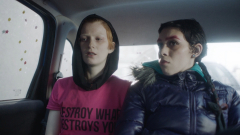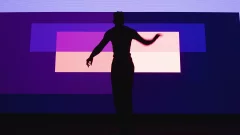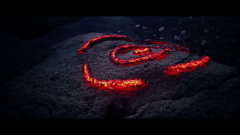Multidisciplinary artist Charlie Osborne explores performance anxiety and liminal space surrounding a mysterious talent show in a haunted bingo hall for her short film, Bury-Man-Lane.
“Aisha, I get so bored like, like I’m internally beating myself up.” These are the first words we hear from Charlie Osborne, a multidisciplinary artist, musician and performer who makes work on the presumption that “the internet is a genre and protection can be found in objects, mascots, easter eggs and symbols.” What follows lands somewhere between an urgent threat and morbid fantasy, free association tripping towards destruction: “I swear to god one day I’ll grab the perfume, you know, not the liquid kind, the aerosol kind, and I’ll grab a lighter, you know, a Clippers, the shiny ones, and I’ll go up in smoke.” It’s this space in-between, a liminality conjured out of performance anxiety and contemporary malaise, that Osborne moves through in her short film Bury-Man-Lane, a portrait at once personal and phantasmic. “Although my writing style is based in magical realism, I kept weaving in real life events,” she says of the film’s stark opening. “There’s a scene where myself and close friend Aisha share dark fantasies in the back of a car. It’s based off this time when a girl at my school did go up in flames in the playground after dousing herself in Lynx and a boy flicking a lighter at her. It was only for a split moment and so she was by miracle un-harmed. I’m always drawn to these ‘close calls’ lucky escapes and this idea of mischief. It’s like a bleak form of entertainment.” Apocryphal tales, intimate myths and surreal, domestic lore proliferate the world of Bury-Man-Lane, in which the mysterious power of an enigmatic talent show, which seems to take place outside of time, in a limbo that may or may not be haunted, generates a gravitational pull through which the film’s characters orbit. “I wanted all my characters to seem like they are in search for something hopeful and that in the fog there’s something good out there for all of us,” Osborne continues. “I wanted there to be a common thread that ties all the characters together and so I chose an event. TV talent shows, music videos and performing for social media became a key reference when thinking about what this ‘event’ in the story of Bury-Man-Lane would be.”
Drifting between surreal CGI sequences – swarms of digital cheese puffs swirling around the film’s titles, a weather beaten talent show flyer, contact telephone full of angel numbers, buffeted by computer-generated wind – and restless, hand held photography, all washed oranges and pinks, Y2K optimism blurring into the dull light of the present, Bury-Man Lane plays out like a fever dream. Osborne’s world is one of plush toy iconography and desiccated frog totems that guide people to their true loves, in which characters down energy drinks to the point of internal haemorrhage and friends transform themselves through finger tip impact meditation, trapped by empathy felt so keenly it’s painful. “Alongside the script I wrote a poem called ‘Metal detector, get me some gold.,’” she notes. “I wanted it to sound like it was beckoning for something and that it was linked to all these characters I’d created. The words, phrases and lyrics started linking back to my childhood in Cardiff. It felt like a thread of rage and the words felt hoarded like, ‘am I really writing about my absent Dad again?’ But at the same time, the poem became an anchor for this entire project.” Bursting forth from the film in a climactic performance, Osborne’s words emerge like a magic spell, an act of magical realist manifestation, the invocation of a hit, the bag, or success, viral, material or otherwise. Drawing together the ritualistic invective of a chewing gum-spat ceremony, the voyeuristic charge of an exploratory bedroom dance recital and the film’s hauntological score of lilting ambience and driving synthesis, a Daniel Lopatin soundtrack refracted through Photo Booth and GarageBand on a knackered laptop, Osborne’s verse and performance channels the crackling potential energy of Bury-Man-Lane, the first and last word.
“Time becomes so warped post graduation,” says Osborne of the film’s conception, which was, in part, made in response to the stress she felt on completing her studies at Camberwell. “It feels like there’s a set of conditions we all have to resist in order to be artists. I don’t want things to be survival of the fittest, although the energy that builds up as a result of this madness can be exciting. Life felt like one big collective talent show amongst many obstacles. I wrote the script for Bury-Man-Lane as a response to that feeling. I was unsuccessful in receiving funding so I saved every penny I could and started shooting with a crew of friends.” The artist zeroes in on this untethered anxiety – conversations are muttered and thrown away, gazes are never met and expressions rarely change. This is no clearer than in the “passing-through space” in which the talent show takes place, a venue richly evocative of warped time and unrealised ambition. Captured in the faded glory of Sydenham Bingo Hall, one unseen character describes the space with the words of a ghost story (“No one ever lives there, no on ever wants to be there, they just gotta be there”) as those trapped in its limbo emotionlessly count pennies, eat crisps and pass a “little fried-ass frog” back-and-forth for eternity. “In my work I like playing with a grubby-glossy aesthetic and I try to get that in my films,” explains Osborne. “When I was location hunting I was thinking about where the characters would hang out. On one hand they are introverted hermits, performing for their phones in a private bedroom, and then on the other hand they are avoiding home, always on the move. The space and set had to enhance their skater, loner, party people, misfit archetypes.”
“It was a real pleasure to work with all the cast whom for most was their first time in a film,” she continues. “When directing I was always craving for it to look slightly contrived, like their emotions were wrapped in plastic. I wanted to story-tell through the choreography as much as the dialogue, so I collaborated with artist Gulliver Whitby to create a twitchy, bird like movement. This image of a flock of birds and a flyer moving across the screen wouldn’t leave my mind. It opened up the idea that somehow my characters are subconsciously dictating one another from scene to scene, through this choreography.” Though at times disconnected, it’s clear that the characters of Bury-Man-Lane are dancing to the same beat, disaffected by t




